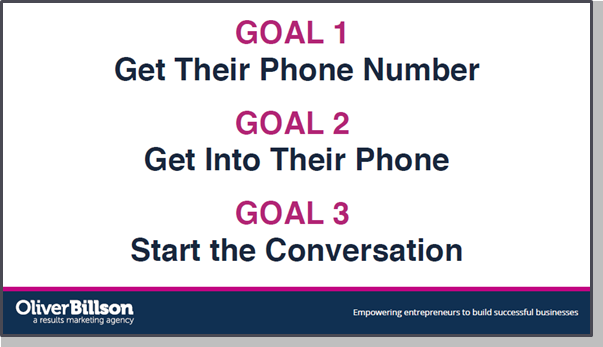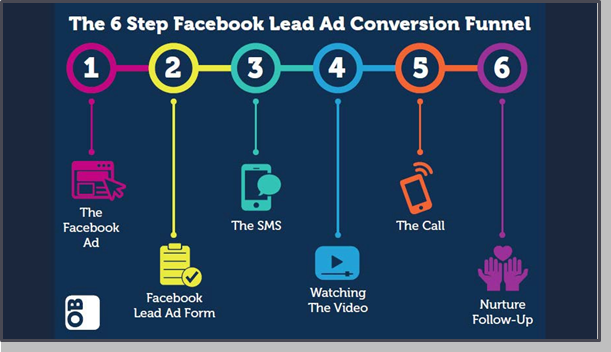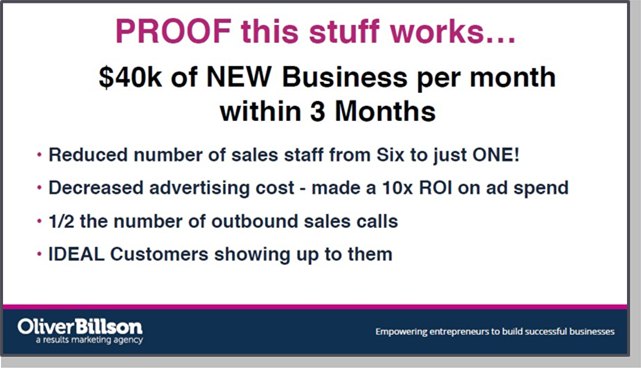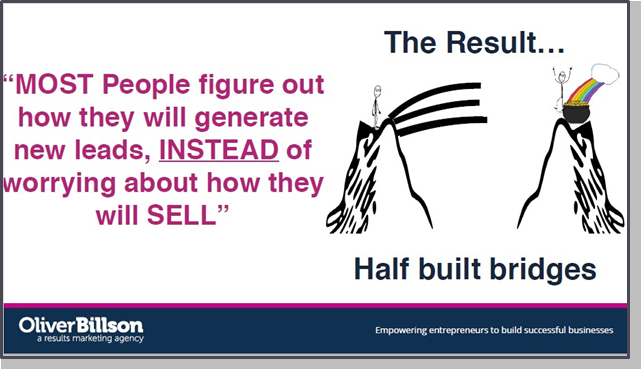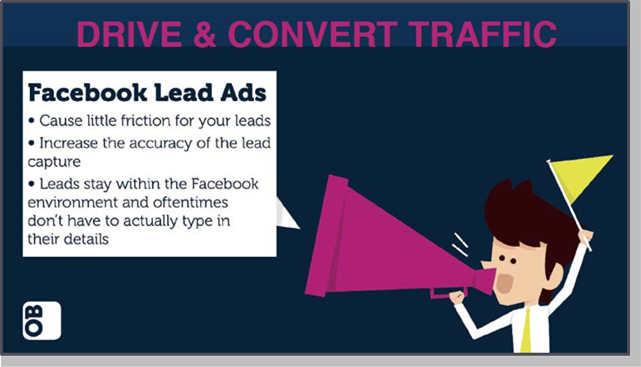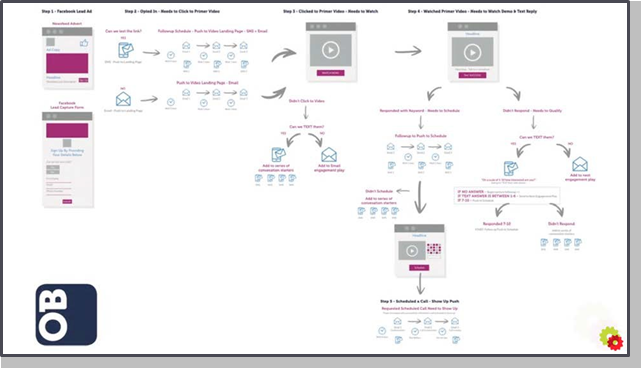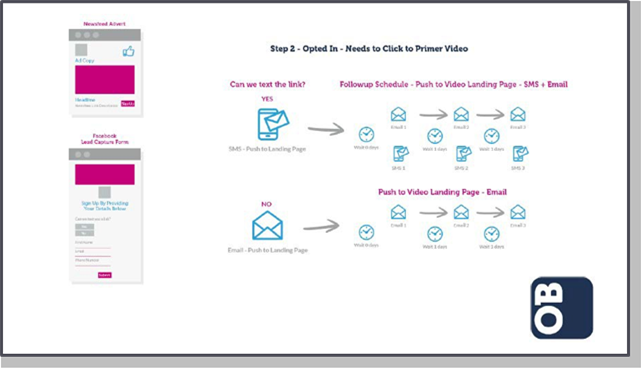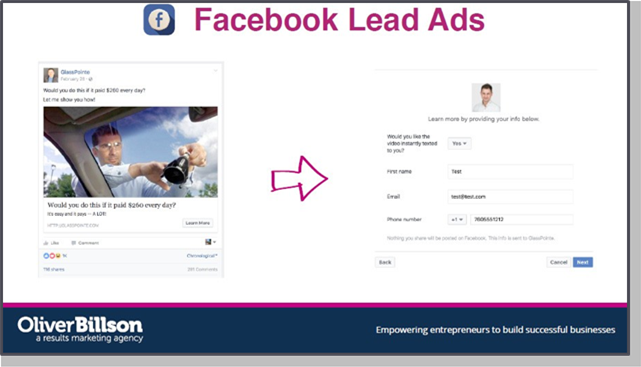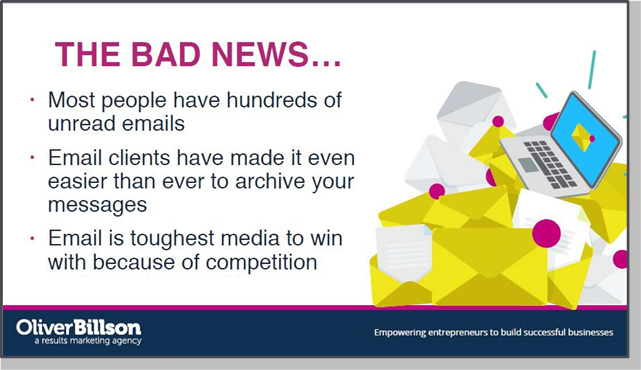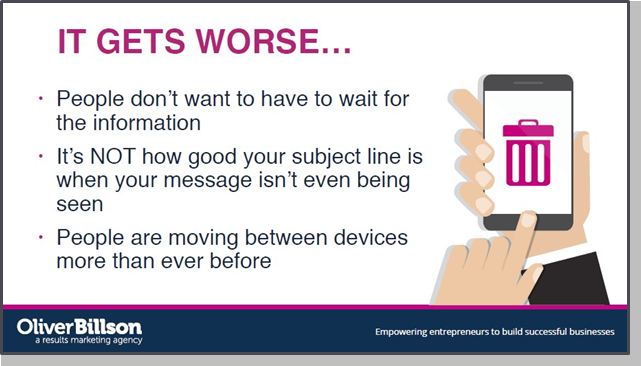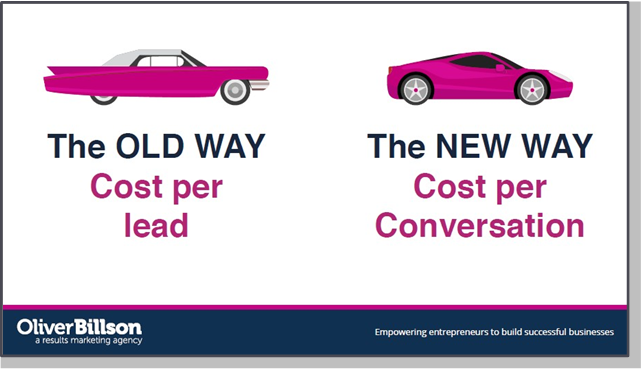Oli Billson
Oli’s superpower lies in strategizing and implementing cutting edge, conversion led, money-making sales and marketing funnels. Oli’s portfolio now spans four incredibly successful businesses, including information marketing, training and coaching, brick and mortar businesses, and his widely sought after “done for you” marketing business.
What I’m going to share with you today is not theoretical. It is something that virtually everybody can apply to their business. It’s something that you’ll be pleased to know is step-by-step simple and that you can implement it in your business right away. I’m going to take you through the whole process.
So, there’s lots of things I could of course talk about, but there’s nothing more impactful than this: the phone funnel. How to predictably drive qualified leads to sales calls.
Before we get going, my assumptions are that you actually have to talk to somebody, you have to have a conversation in order to make a sale. What
I can tell you is that what I’m going to share will absolutely have a profound impact on your business, and I know that because we are in the trenches doing this and implementing this type of funnel for people right now and also for our own businesses, so I know that it can absolutely make sense for you to implement in your own.
We’re going to talk about how to fully leverage the power of mobile marketing, and I’ll share with you how that plays together with your sales process. We’re also going to talk about how to drive qualified sales
appointments from cold Facebook ads. We’re also going to talk about the six key elements of the Facebook funnel, and how you can drive quality traffic predictably and consistently for your business.
This information is for you, regardless of whatever type of business you’re in. Whether you’re a brick and mortar business owner, a service-based business, an information marketer, even a SaaS-based business. This is totally applicable for you and works in all these different types of categories. We know because we’ve tested them, and it quite simply gets results.
For us, obviously, we’re an agency and unsurprisingly this is how we actually attract and acquire customers as well. Franchise or SaaS, there we go. Coach, consultant, author, speaker, or, my favorite, industry transformer. I absolutely hate that terminology, but it is what it is.
If you want to break through the frustration of getting more customers with less stress and headache, then you’re in the right place. Many of you reading this may have never heard of me before, and this might be the first time we’re interacting. So, let me start with a little bit about me, and my background.
I started my first business at the age of 15. I’ve never worked for anybody since, so I’m definitely, completely unemployable now. I was exporting computers to the Far East at the age of 15. Interesting situation when DHL vans arrive to your parents’ house to pick up boatloads of servers to take to Egypt, and they wonder what the hell’s going on.
As I mentioned, I live this stuff. I’ve been in the fortunate situation to grow from zero, four separate multi-million-dollar businesses, in different sectors, and of course spend a lot of my time now in our marketing agency. One of those businesses, one of the case studies that I’m going to share with you, we grew from zero to 170 franchisees internationally in less than four years. Recently, went on a holiday to Jamaica, and lo and behold we have our franchisee there, which is super cool. We initially attracted and converted them into a franchisee through this exact funnel.
On the personal side of things, I’ve got a 10-year-old son Spencer who is kind of techy like I am. He was building Infusionsoft campaigns when he was six years old. So, any of you who thinks it’s like “Confusion-soft,” well, a five- year-old can do it. I’d like to think he had a good mentor, though. I’ve got a four-year-old daughter Sienna who’s not quite so technical and is an absolute nightmare to be quite honest with you.
Away from the business side of things, I’m a complete, what we call, a petrol- head. But really, I’m a car geek, and I love expensive watches, surprisingly.
This is our little family here, let’s get through this. There we go. Little side things. So, I recently got engaged. But, I’d already been engaged to the same person for 11 years. Been together 14 years, and just re-proposed. So technically I’ve bought myself another 11 years.
I spend most of my time now, obviously, in our agency helping people grow and scale their business. We’re fortunate to work with some amazing people, amazing brands, and people that you may know and heard of in this industry that are making waves. We are running all their marketing for them, all of their front-end acquisition funnels, traffic, copy, everything that you can imagine that a full marketing department would be running. We get to see a lot of stuff.
Now, what I’m going to share with you here, I just want to preface this with a bit of a warning: it defies conventional wisdom and kind of goes against the grain of what a lot of people will tell you what you should do to drive quality leads into sales appointments.
What I would challenge you to think about as we go through this is: would it be worth you to adjust the way that you do things so that you could provide a better lead to costumer experience that would not only just convert more qualified leads, reduce lead to buyer time, and then what you may have heard before around things that are like funnels? Because that’s exactly what we’re going to be talking about here.
I just want to kind of kick off with where you would normally end. So, I’ll start with the end in mind and just share with you two case studies and just share the proof that this stuff absolutely works and why you want to be paying attention for the rest of this presentation.
Case Study #1
This business sells a business opportunity, and the business previously had never done any Facebook advertising at all. This was brand new for them, but they did have a direct sales team and they wanted to explore the traffic channel. They generated 61,000 leads, at a cost of $1.67 per lead, 102,000 in advertising spent, generating through the phone funnel framework that we’re going to talk about here.
All in all, they have a seven-times return on ad spend. Does that sound good? What’s best, they brought in $65,000 worth of new business within their first three months of implementing the funnel. They reduced the number of sales staff from six to just one. They decreased their advertising spend that through the other channels were previously exploring and managed to get a seven-x return on investment. They halved the number of outbound calls that they were making, and they reduced their lead to buyer time down to 21 days.
Those are the real benefits. I gave you hard the figures, but those were the real benefits to the business.
Case Study #2
Let me share with you one of my businesses and my story. We started out about six years ago selling a franchise. A high-ticket franchise. To be quite honest with you, I’ve been in the direct response world for nearly 12 years, so we do a lot of mixed media both online and offline. We had a very traditional funnel, and it was quite complicated. We had multi-step, multi-media, offline, shock and awe, to discovery day. It was comprehensive, and it worked,
but one of the main things that we used to sell through was an automated webinar.
Not that there’s anything wrong with that, we just found a better way of doing it. A way that actually got results, that provided a better experience, and actually opened up the conversation with people. That made the difference.
These were our results: we generated 12,000 leads at a cost of $7 a lead. 90,000 in advertising spend. All cold lead generation on Facebook.
Generated 624 appointments. We generated, in total, $800,000 or so in revenue. Return on our spending, 9x. I just wanted to share with you this was selling only 34 units. So, it’s a low in number but high in ticket. Just to prove to you the concept that this absolutely works. So, we changed from a complicated webinar to simple funnel and got: 9x return ad spend and increased consumption.
Have you ever been to a conference, live event or listened to a training, and got all jazzed up about what you learned? You bring out a massive white board, maybe two, maybe three, maybe you just buy another one, and you start mapping out your funnels, right? When you come to implement them, you realize that that’s going to take some time, and that can be frustrating. That can hamper you from success.
Information alone, as you know, won’t help you. Implementation will eventually allow you to get to transformation in your business.
A lot of people look at funnels like this: from the outside. We’re told it’s supposed to be easy; It’s A, B, C, and you need to implement this, that it’s supposed to be the next big thing that you should do. Actually, what it ends up being is a very disjointed path that’s extremely difficult to measure and more importantly difficult to scale. The reason why that is the case partially is because most people don’t start in the right place as my good friend, and
he’s not really my friend, Stephen Covey says: You need to start with the end in mind.
You should always know how you’re going to sell to somebody before you go to lead generate. See the thing is, driving traffic is super easy. Buying media is super easy. No problem with that stuff. But if you need to actually have a conversation with somebody in order for them to actually buy from you, that’s a different type of funnel. It’s a different process. The challenge is that most people start in the wrong place.
Most people figure out how they will generate new leads instead of worrying
about how they’re going to sell to them.
Generating leads at low lead cost is super easy. You know: drive into a checklist, information first strategy, lead magnet, video series, whatever. It’s irrelevant if you’re not capturing their phone number because you need that in the sales process to actually speak to them. Of course, there’s ways to do that, get them to opt in first and then on the second step get them to provide more information to you, et cetera. The reason why most people don’t do that is because the more you ask for, the lower the conversion. That’s where things can change for you with this process, and that is with the six step Facebook lead ads conversion funnel.
Have you ever tried lead ads in their business before? I’m going to share with you a new way of making this work. Now this is of course the 30-thousand- foot view of it. Now, the first goal that you have is to actually get their telephone number because remember we’re starting with the end in mind.
How do you do that without decreasing conversion? How do we open up channels of communication that we’re going to need in the sales process?
Facebook lead ads provide a very efficient opportunity for us that you’re
probably under-leveraging right now, and that’s because Facebook holds
so much data on their inventory of their users that it provides a frictionless experience for them inside of Facebook, inside of the environment that they’re searching within, that pre-populates their information. Not only is it accurate, but there’s very little resistance for them to give you what they
need. That provides an interesting opportunity for us to explore, which you’ll see shortly.
In the recent Facebook internal report, an aggregation of their data, 80% of the people that were using lead ads from traditional conversion led objectives have had an 80% in reduction in lead costs, a 10x number in leads across their different ad campaigns they were running. In total, 90% of all their results were actually coming from lead ads. Quite interesting.
Lead ads do work on multiple devices. They do work on mobile and they also work on desktop. You can serve them up on both. All of our funnels, the standard operating process in order for you to administer this you should always be targeting in all of your ad sets on mobile devices. The reason why you should be doing that is it is a very quick and easy process for them to give you their information, and there is a congruency between the response mechanism, what information that that you’re giving in advance of what type of lead magnet it might be. I’m just sharing with you how we do this with
a video in a few moments, and how it replaces a webinar and the delivery mechanism.
What do I mean by that? Well, if I’m on a mobile phone, and I know that I’m targeting mobile, and the promise is that I’m delivering a video to those people, I’m not then going to send them off their mobile device because I want them to consume the thing that they’ve actually asked for. Consumption is key. It is critical to them to build a relationship with you, to get them
to know, like and trust you. In order to do that, you need to get them to consume your stuff.
That’s a big thing with automated webinars. However, you back them out, whether they’re just in time, whether you’ve got specific days that you run them, the challenge that you’re always going to face is getting people on them, getting them all the way there to the end to see the offer.
Mini-Tutorial -Setting Up Facebook Lead Ads
This way you have a very straight-forward process that they requested from their mobile phone you’re delivering directly to their mobile through mobile marketing. Now for those of you who don’t know how to set up Facebook Lead Ads I wouldn’t normally give a complete breakdown of how this works and but in this case, I do want to share with you how easy this is for you to actually go ahead and do it. I’m big on you taking action and that’s really what I want you to do on the backend of this presentation.
In Ads Manager in PowerAds you go to Campaign. The objective that you want to select is Lead Generation. You won’t see something called lead ads there. Lead Generation is what you want. What you will do if you haven’t used it before, is you want to accept their terms and conditions, that’s absolutely normal. There are a few nuances with this that you’ll probably want to consider that I’ll share with you in a few moments.
Here in the Ad Set level, we’re targeting mobile-only. We select to create a new lead ad form and then select the information we want to collect, just like a web form that you’d be setting up in your auto-responder under
Infusionsoft active campaign whatever. We want to be selecting three things: first name, e-mail, and phone number. Remember we need that information in order to start a conversation with them. We then want to, again you wouldn’t normally want to do this on an opt-in form, you want to be able to have a question that you’re going to ask them. Now this is really where things start to get interesting and play towards the mobile marketing aspect of what we’re talking about.
This is what it says: Would you like the video instantly text you? That’s what is says, and there’s two options. Either yes or no. 80% of people who fill in these lead ad forms, by the way, say yes, in our experience. We’ve got this process that I’ve mentioned works for virtually every type of business, certainly would work for everybody here I’m sure is no different.
Now the promise, the thing they’re opting in for from the ad, is a video. This is normally replacing a demo in a SaaS business. It’s replacing an automated webinar in a normal information marketing, knowledge-based business. We ask for their permission if we can text it to them.
There are some terms and conditions that you’ll want to set up on your website. This is just a link back to your website that you are collecting information with lead ads. Now I did this the other night in a hotel room and it took me 12 minutes. I timed it. Do you think you could go through this exact process and make that work for you? Pretty straightforward.
Finally, there is a thank you screen that once you’ve entered their information in, they get directed to. Now, you can get them to go and visit a website straight after. So, you can get them to redirect to another destination afterwards.
Here’s a little trick for you. Do you use ManyChat or some kind of chat bot? ManyChat provides URL that then can start a messenger bot conversation, and you can actually put the destination of ManyChat into the Thank You URL so not only have you got their name, their e-mail, and their phone number
to start the conversation, for those of them that are high corresponders that want to ask a question immediately, you can now, in a multi-media way, start to conversate with them through ManyChat.
Do you want to know how to predictably drive leads into sales calls? As soon as they tap it on their mobile device, it says, “Would you like the video instantly text to you?” Yes, is on the drop-down, very quick and easy. Everything is pre-populated. They don’t have to enter their mobile phone number in there, and then there’s a thank you. Now we can get them to go and watch the video.
OK, that ends the “mini-tutorial,” let’s get back on track with WHY this is so powerful.
Here’s the other thing that happens simultaneously with them entering in their information just like filling in a web from, you’re going to sink this information directly into your auto responder system. For those of you using a platform such as Infusionsoft, this will be led directly into it using a software called Fix
Your Funnel. They have a software there inside of Fix Your Funnel called Fix Your Funnel Sync, all of the lead ad information goes directly into Fix Your Funnel.
If you’re not a Fix Your Funnel user, and you use ActiveCampaign or something else, then you can use Zapier to zap it in there no problem at all. The custom fields and Infusionsoft are taken care of. Can we text it to you is in there for future reference, so you’ve got permission to continue the conversation with them afterwards? Everything is synced perfectly. We even
set up a Slack notification to our sales team just to let them know that we’ve just had a new lead directly come through so that they can begin the process of communicating with them through text messages depending upon their process and contingencies in the funnel.
This provides a unique opportunity for us. A new opportunity. One that I would strongly encourage you to adjust your mindset of what you are doing right now if you have to speak to somebody to make a sale in some way, shape, or form. It is the new opportunity to connect with the device that’s in everybody’s pocket.
I don’t know about you, sometimes I play a game. I look up here over at some people’s phones sometimes and just see what that number says. I know mine’s pretty big. Of course, we’re all in the business of aggregating attention. Can I just ask a quick question? How many of your businesses would die almost instantly within a week if you could only communicate through e-mail? So, if e-mail is taken away from you, you’d be knackered. This provides an interesting opportunity because the truth is receiving text messages is quite personal, isn’t it. Open rate on text messages, by the way, is pretty high.
I’m going to share with you how you can actually get into people’s phones in a more personal way in a few moments, but the bad news is obviously more people are receiving more e-mails than ever before, there’s issues with deliverability, and if you use something like Google Inbox, it’s easier than
ever before to archive a bunch of messages all in one go. Really, e-mail is the toughest media to compete in because you’re competing with everybody. I mean, even for my swipe farm, and my team swipe farm, they’ve even got a separate e-mail account just to be other people’s lists right? Also gets worse that people don’t want to wait for information any more.
The reason why we were able to get those results is because we were able to deliver it to them immediately. Get it to the device that they want to consume it on immediately cause that’s how they’re responding. Remember, that congruency between the response mechanism and the delivery mechanism is absolutely critical. People obsess over how good’s my subject line, how can
I get noticed, how can I stand out in the inbox? And the truth is that you end
up fighting the laws of diminishing returns with e-mail. You absolutely do.
For those of you who are savvy e-mail marketers, you’ll also know that from a deliverability standpoint, if you’ve got a list of a 100,000 people, you’re not actually delivering to a 100,000 people because chances are they may be marketable, they may have opted in at some point in the past, but they’re not engaged. See, you need to do all sorts of fancy things with your e-mail marketing software to figure out those people that are engaged, those people that have not engaged or clicked or opened it in 30 days, 60 days, 90 days. How many people have opted out? I mean, it’s crazy.
This is a way to overcome that, and I strongly encourage you to really put this process into your business. Following it up with e-mail, I’m not saying it’s dead, but mixing up the modality and the media is critical to making this work. Now the thing is with lead ads is that when somebody requests that
information from you, you can actually automate them to send them a V-Card.
A V-Card is a way of delivering a packet of information to their mobile device so that it saves all your information to their mobile phone because guess what, when I want to then strike up a conversation with you through text messages and you’re just getting text messages from a number that you don’t recognize, that’s more of a problem. It doesn’t feel right, does it?
So now you can send all your information to them. Phone number, even a picture. If you’re a franchise and you’ve got different business locations all the locations can be listed in their mobile phone.
It also makes it easy for them to share that information. If you’re a local business, and you said to me, “Hey, I’ve got a leak. I need a plumber.” The first thing I’m going to pull out is my mobile phone to figure out John’s number from down the road, right? This allows you to do that and it’s strongly encouraged as part of the process that when you’ve got their phone number, that’s the first thing that you do. You send them the contact information before you then start the follow-up.
Let’s talk about multi-step, multi-media follow-up and once you’ve got the lead information, how you can then make it work for you because we all know that you want to follow up at the right time, at the right moment that
somebody’s to capture their interest, capture their attention, and be more like
a sniper rifle than a shotgun.
But when we ask them that question, “Can we text you a link to the video,”
we then set up a series of automated follow-ups.
Now, most people try to over-automate the process, and that’s the reason why they get complicated, they often get frustrated, and they don’t get things implemented. With this, it’s a very straightforward set of
communications. Multi-step multi-media. Not just through the phone because remember, that’s what they responded from. Back in the day, from a direct response perspective, if I was a lead generating somebody offline, online, meaning I was sending postcards, a sales list, or something like that to get them to a webpage to look at something, often when they got online guess what I’m going to do? I’m going to send them offline pieces again because that is the congruency because how they initially responded in the first place. It’s no different here.
They initially responded from their mobile device, and they requested the information, and therefore I’m going to deliver it to them to their mobile device with text messages. Now of course if they said No and we said the conversion is about 80% of people that do say yes, then we would just follow- up with e-mail.
We do a lot more based on relationships than we ever do logic. The thing is that e-mail drives a lot of behavior, okay? But text message, mobile
marketing, is different. It allows us to have a conversation with people so that we can actually get them to increase the consumption of our good quality content so that we can move them forward. Now that we have got them to a point where we’ve got their information, we’ve got into their mobile phone, we have then sent them our V-Card so we know who they’re communicating with.
What we’re going to do is we’re not going to send them directly to our presentation, our video presentation. We’re going to send them to a primer video. For those of you who’ve ran webinars for some time or any length of
time, you’ll know that this is like a pre-indoctrination strategy to pre-frame and preface what they’re going to experience and what they’re going to learn as part of the webinar.
Imagine this: Because we’re reducing the time that they’re responding, remember they’re responding on their mobile device, to them seeing a text message to go and watch a video, it is like bam, bam, bam. If we take them straight into the presentation too quickly and we expect them to sit there for 25 minutes, 50 minutes even, that’s a problem. The primer video acts as a way for us to tell them that we’ve put together this presentation, and these are the things you’re discover, and it really sets up what to do next.
They see this first, on their mobile device to pre-frame what they’re about to watch and then they can click a button then to get to the actual main video. These micro-commitments are a big part of this process.
You might be thinking to yourself, “Okay, I’ve requested this video from Facebook. It was all very quick and easy and less than 30 seconds. I’ve now got a text message telling me to go and take action and whatever and see this stuff I’ve requested.” What happens to those people who don’t take action? Of course, you need to set up contingencies. The beautiful thing is you can do this quite easily with automation but without over-automating to bring them back to the milestone that they’re at, the milestone that they actually didn’t click to watch the video. We can just softly remind them that they need to go back to consume and go and watch it.
An example bit of copy here that we used: “Did you get a chance to watch the video I sent you? If not, here’s the link you needed.” Pretty much it’s like a car abandonment e-mail, just a soft push back there. And SMS.
Equally so, because you can communicate both with e-mail and text messaging now, the benefit you’ve got is you can simultaneously send these messages so that you can get their attention and them back to where you want them to be. Texting them becomes the gateway to the telephone because regardless of where they drop out in the process, you’re able to then continue to start a conversation with them and that then can segue to, “Does it make sense that we got on the phone together?”
As I mentioned, we use Fix Your Funnel to do this. If you’re not a Fix Your Funnel user, not an Infusionsoft user, then you can use something called Yext, which is great for those of you that don’t use it.
For those of the people that consume the primer video, this is where we kind of get into things. This is the main event. This is the thing that we will actually want them to go and consume. Now the video, in our experience, can be
as short as 25 minutes in length and maximum it should be no more than 50
minutes. Really, it’s a condensed webinar presentation.
What we do is at the part of the presentation usually where you’d be getting somebody to pitch, you’d be pitching to go and take action on something. So, on a webinar you might be saying, “Go and claim your free Discovery card.” Or it’s a diagnostic consultation and it’s 500 dollars or whatever it may be. What we do here is get them to text in a key word so that then we know we’ve elicited that response from them as part of the presentation. That then triggers a series of communications to get them to go and schedule a call.
They’re watching this video and I say, “Does this all make sense to you, are you getting this?” Yeah it sounds great. “Okay. For those of you who want to take advantage of this offer right now, text the word Success and we’ll send you the link to go and schedule.”
What happens then, is the people that requested the key word, the next milestone is obviously for them to go to the scheduling link to go and schedule with one of the sales team (whatever software you use obviously this will work with that). For those that didn’t respond, those that got to the presentation and they didn’t finish or take that little micro-commitment to get to schedule, what we do is through text messages, we can then automate the follow-up by saying “Okay. So you watched the video, I hope you enjoyed the concept. Now, on a scale of 1 to 10, how interested are you?”
If you notice, all of this conversation, this communication, is very conversational. Big difference, but I said e-mail drives a lot of behavior. When you’re communicating with people on the mobile devices, it’s very, very different.
Depending upon their response, if they’re a seven to 10, then we can trigger
further automation to begin the process of following up with them more
effectively. Really, the cream rises to the top. They’re qualifying themselves. This is about driving qualified leads into your sales team. So, example, a bit of swipe copy here: “What did you think of the video? Did you have any questions?” These are good conversation starters. “It looks like you visited our scheduling link, but you didn’t book a call. What’s holding you back?” Very conversational.
This is all about conversation-based marketing. The old way of looking at things would be “What’s my cost per lead like, I want to drive my cost per lead down,” versus “What’s the actual cost of having a conversation? Like a meaningful conversation with someone who’s actually interested so I don’t have to waste my time with people that are just not in a position right now to move forward?”
Some examples, we break these into two for follow-up and look at copy that works. We use an engagement-based starter, something like “Hey, this is John from Ollie’s office. I noticed you watched the video. What did you think of the concept?” Versus a sales interest starter, which is, “Hey it’s John from Ollie’s office. Ollie’s put together a special bonus for four people.
Would you like to know more about that?” There are the two types of communication that you want to be sending. You want to be very respectful of the opportunity to communicate with people in a very personal way.
The technology that’s available now allows you to have this two-way conversation with people. Your sales team can be sitting and instead of dialing the phone, they can be having these inbound conversations with people through their mobile device, it’s very fast, very transactional, and bubbling them up to having a meaningful sales conversation through an appointment with them.
It’s important to know that you should talk to people, not at people. Would you agree? Sometimes you do this with e-mail? You come to send an e-mail broadcast style and it just doesn’t feel quite right sometimes. You’re just trying to aggregate attention. It’s a mistake people are making. Of course, for someone to actually buy to you from a sales perspective, they’ve have to buy into you. It’s a big difference. The secret sauce, really, is segueing
from marketing to sales and now you can do that in a seamless transition like you’ve never been able to do it before by leveraging some of this technology.
Now to recap, this is the full blueprint of what we spoke about, the 6-Step
Facebook Lead Ad Conversion Funnel:
- The Facebook Ad
- Facebook Lead Ad Form
- The SMS
- Watching the Video
- The Call
- Nurture and Follow Up

